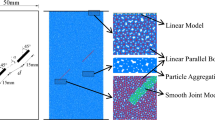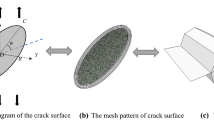Abstract
The strain energy density softening criterion is introduced to the peridynamic theory to reflect the failure characteristics of rock-like materials. At the same time, the critical damage condition, obeying Weibull distribution, is utilized to describe the heterogeneity of rock—making up for the deficiency that the peridynamic method cannot embody the strain-softening features and heterogeneity of rock when simulating crack propagation of rock materials. The crack extension process of rock, with a single crack under uniaxial compression, was simulated using the improved method, the results of which were then compared to the results of previous laboratory tests to verify the effectiveness of the proposed theory. Furthermore, the crack propagation patterns and failure mechanism of rock materials which contain single crack and double cracks with different prefabrication angles under uniaxial compression condition were explored in this study. The results showed that the propagation of a prefabricated single crack specimen was divided into wing crack, shear crack, and anti-wing crack, and the order of appearance was influenced by the inclination angle. The penetration modes of prefabricated double cracks were divided into wing mode (W-mode), shear mode (S-mode), and mixed mode (M-mode), which were primarily affected by the inclination angle and relative angle.
Similar content being viewed by others
References
Wong, R., Chau, K.T., Tang, C.A., Lin, P.: Analysis of crack coalescence in rock-like materials containing three flaws - part I: experimental approach. Int. J. Rock Mech. Min. 38, 909–924 (2001)
Zhang, X., Wong, L.N.Y.: Choosing a proper loading rate for bonded-particle model of intact rock. Int. J. Fract. 189, 163–179 (2014)
Yang, S.: Crack coalescence behavior of brittle sandstone samples containing two coplanar fissures in the process of deformation failure. Eng. Fract. Mech. 78, 3059–3081 (2011)
Ma, G., Li, T., Wang, Y., Chen, Y.: Numerical simulations of nuclide migration in highly fractured rock masses by the unified pipe-network method. Comput. Geotech. 111, 261–276 (2019)
Cao, P., Liu, T., Pu, C., Lin, H.: Crack propagation and coalescence of brittle rock-like specimens with pre-existing cracks in compression. Eng. Geol. 187, 113–121 (2015)
Mejia Camones, L.A., Vargas Jr., E.D.A., de Figueiredo, R.P., Velloso, R.Q.: Application of the discrete element method for modeling of rock crack propagation and coalescence in the step-path failure mechanism. Eng. Geol. 153, 80–94 (2013)
Camones, L., Vargas, E.D., Velloso, R.Q., Paulino, G.H.: Simulation of hydraulic fracturing processes in rocks by coupling the lattice Boltzmann model and the park-Paulino-Roesler potential-based cohesive zone model. Int. J. Rock Mech. Min. 112, 339–353 (2018)
Alhadeff, A., Leon, S.E., Celes, W., Paulino, G.H.: Massively parallel adaptive mesh refinement and coarsening for dynamic fracture simulations. Eng. Comput.-Germany. 32, 533–552 (2016)
Zhang, X. S., Chi, H., Paulino, G. H.: Adaptive multi-material topology optimization with hyperelastic materials under large deformations: A virtual element approach. Comput. Method. Appl. M. 370, 112976 (2020)
Spring, D.W., Paulino, G.H.: Achieving pervasive fracture and fragmentation in three-dimensions: an unstructuring-based approach. Int. J. Fract. 210, 113–136 (2018)
Gajewski, J., Golewski, P., Sadowski, T.: Geometry optimization of a thin-walled element for an air structure using hybrid system integrating artificial neural network and finite element method. Compos. Struct. 159, 589–599 (2017)
Hemmatian, H., Zamani, M.R., Jam, J.E.: Elastic moduli of boron nitride nanotubes based on finite element method. J. Mech. Mater. Struct. 13, 351–363 (2018)
Belhocine, A., Abdullah, O.I.: A thermomechanical model for the analysis of disc brake using the finite element method in frictional contact. J. Therm. Stresses. 43, 305–320 (2020)
Talischi, C., Pereira, A., Menezes, I., Paulino, G.H.: Gradient correction for polygonal and polyhedral finite elements. Int. J. Numer. Methods Eng. 102, 728–747 (2015)
Beghini, L.L., Pereira, A., Espinha, R., Menezes, I., Celes, W., Paulino, G.H.: An object-oriented framework for finite element analysis based on a compact topological data structure. Adv. Eng. Softw. 68, 40–48 (2014)
Muixi, A., Marco, O., Rodriguez-Ferran, A., Fernandez-Mendez, S.: A combined XFEM phase-field computational model for crack growth without remeshing. Comput. Mech. 67, 231–249 (2021)
Bhattacharya, S., Sharma, K., Sonkar, V.: Numerical simulation of elastic plastic fatigue crack growth in functionally graded material using the extended finite element method. Mech. Adv. Mater. Struct. 24, 1367–1380 (2017)
Yu, T.T.: The extended finite element method (XFEM) for discontinuous rock masses. Eng. Comput. 28, 340–369 (2011)
Yuan, C., Moscariello, M., Cuomo, S., Chareyre, B.: Numerical simulation of wetting-induced collapse in partially saturated granular soils. Granul. Matter 21, 64 (2019)
Thoeni, K., Giacomini, A., Lambert, C., Sloan, S.W., Carter, J.P.: A 3D discrete element modelling approach for rockfall analysis with drapery systems. Int. J. Rock Mech. Min. 68, 107–119 (2014)
Dmitriev, A.I., Psakhie, S.G.: Molecular-dynamics study of the initial stage of nanoscale deformation localization in the surface layers of a loaded solid. Tech. Phys. Lett. 30, 578–579 (2004)
Zhao, F., Wang, S., Guo, J.: Experimental and molecular dynamics simulation study on the effects of the carbon chain length of Gemini surfactants on the inhibition of the acid-rock reaction rate. Langmuir. 37, 5232–5241 (2021)
Silling, S.A.: Reformulation of elasticity theory for discontinuities and long-range forces. J. Mech. Phys. Solids. 48, 175–209 (2000)
Silling, S.A., Epton, M., Weckner, O., Xu, J., Askari, E.: Peridynamic states and constitutive modeling. J. Elast. 88, 151–184 (2007)
Silling, S.A., Bobaru, F.: Peridynamic modeling of membranes and fibers. Int. J. Nonlin. Mech. 40, 395–409 (2005)
Gu, X., Zhang, Q., Huang, D., Yv, Y.: Wave dispersion analysis and simulation method for concrete SHPB test in peridynamics. Eng. Fract. Mech. 160, 124–137 (2016)
Zhou, X., Gu, X., Wang, Y.: Numerical simulations of propagation, bifurcation and coalescence of cracks in rocks. Int. J. Rock Mech. Min. 80, 241–254 (2015)
Gerstle, W., Sau, N., Silling, S.: Peridynamic modeling of concrete structures. Nucl. Eng. Des. 237, 1250–1258 (2007)
Huang, D., Lu, G., Wang, C., Qiao, P.: An extended peridynamic approach for deformation and fracture analysis. Eng. Fract. Mech. 141, 196–211 (2015)
Ha, Y.D., Bobaru, F.: Characteristics of dynamic brittle fracture captured with peridynamics. Eng. Fract. Mech. 78, 1156–1168 (2011)
Diehl, P., Franzelin, F., Pflueger, D., Ganzenmueller, G.C.: Bond-based peridynamics: a quantitative study of mode I crack opening. Int. J. Fract. 201, 157–170 (2016)
Lee, J., Hong, J.: Crack initiation and fragmentation processes in pre-cracked rock-like materials. Geomech. Eng. 15, 1047–1059 (2018)
Zhou, X. P., Shou, Y. D.: Numerical Simulation of Failure of Rock-Like Material Subjected to Compressive Loads Using Improved Peridynamic Method. Int. J. Geomech. 17, 04016086 (2017)
Ai, D., Zhao, Y., Wang, Q., Li, C.: Experimental and numerical investigation of crack propagation and dynamic properties of rock in SHPB indirect tension test. Int. J. Impact Eng. 126, 135–146 (2019)
Gao, C., Zhou, Z., Li, Z., Li, L., Cheng, S.: Peridynamics simulation of surrounding rock damage characteristics during tunnel excavation. Tunn. Undergr. Sp. Tech. 97, 103289 (2020)
Silling, S.A., Askari, E.: A meshfree method based on the peridynamic model of solid mechanics. Comput. Struct. 83, 1526–1535 (2005)
Huang, D., Lu, G., Qiao, P.: An improved peridynamic approach for quasi-static elastic deformation and brittle fracture analysis. Int. J. Mech. Sci. 94-95, 111–122 (2015)
Carpinteri, A., Lacidogna, G., Pugno, N.: Scaling of energy dissipation in crushing and fragmentation: a fractal and statistical analysis based on particle size distribution. Int. J. Fract. 129, 131–139 (2004)
Lee, Y., Pietruszczak, S.: A new numerical procedure for elasto-plastic analysis of a circular opening excavated in a strain-softening rock mass. Tunn. Undergr. Sp. Tech. 23, 588–599 (2008)
Rahman, R., Foster, J.T.: Peridynamic theory of solids from the perspective of-classical statistical mechanics. Physica. 437, 162–183 (2015)
Le, Q.V., Chan, W.K., Schwartz, J.: A two-dimensional ordinary, state-based peridynamic model for linearly elastic solids. Int. J. Numer. Methods Eng. 98, 547–561 (2014)
Fang, G., Liu, S., Liang, J., Fu, M., Wang, B., Meng, S.: A stable non-ordinary state-based peridynamic model for laminated composite materials. Int. J. Numer. Methods Eng. 122, 403–430 (2021)
Wang, H., Xu, Y., Huang, D.: A non-ordinary state-based peridynamic formulation for thermo-visco-plastic deformation and impact fracture. Int. J. Mech. Sci. 159, 336–344 (2019)
Sih, G.C., Gdoutos, E.E.: A modified strain-energy density criterion applied to crack-propagation. J. Appl. Mech.-T. ASME. 49, 678–679 (1982)
Sih, G.C., Chu, R.C.: Characterization of material inhomogeneity by stationary values of strain-energy density. Theor. Appl. Fract. Mec. 5(151–161), 151–161 (1986)
Lei, Y., Yujing, J., Bo, L., Shucai, L., Yang, G.: Application of the expanded distinct element method for the study of crack growth in rock-like materials under uniaxial compression. Front. Struct. Civ. Eng. 6, 121–131 (2012)
Li, Y.P., Chen, L.Z., Wang, Y.H.: Experimental research on pre-cracked marble under compression. Int. J. Solids Struct. 42, 2505–2516 (2005)
Wong, R., Chau, K.T.: Crack coalescence in a rock-like material containing two cracks. Int. J. Rock Mech. Min. 35, 147–164 (1998)
Author information
Authors and Affiliations
Corresponding author
Additional information
Publisher’s note
Springer Nature remains neutral with regard to jurisdictional claims in published maps and institutional affiliations.
Rights and permissions
Springer Nature or its licensor holds exclusive rights to this article under a publishing agreement with the author(s) or other rightsholder(s); author self-archiving of the accepted manuscript version of this article is solely governed by the terms of such publishing agreement and applicable law.
About this article
Cite this article
Ma, P., Li, S., Wang, X. et al. Numerical simulation of crack propagation and coalescence in rock materials by the peridynamic method based on strain energy density theory. Comput Geosci 26, 1379–1396 (2022). https://doi.org/10.1007/s10596-022-10172-4
Received:
Accepted:
Published:
Issue Date:
DOI: https://doi.org/10.1007/s10596-022-10172-4




